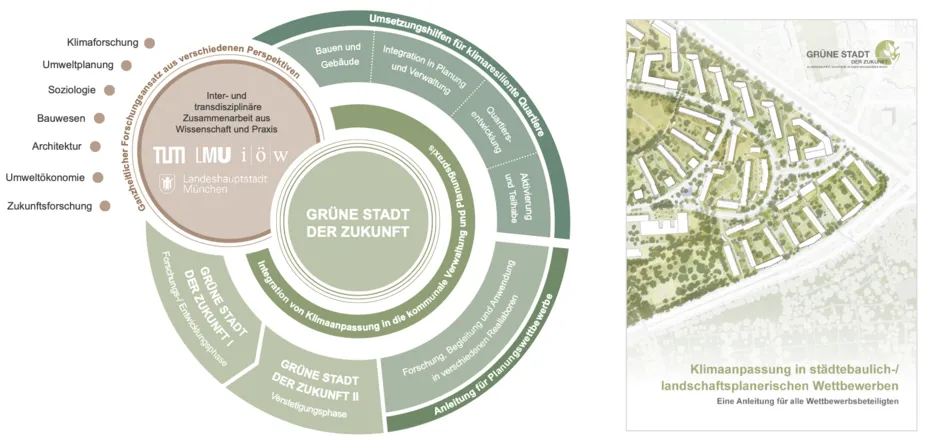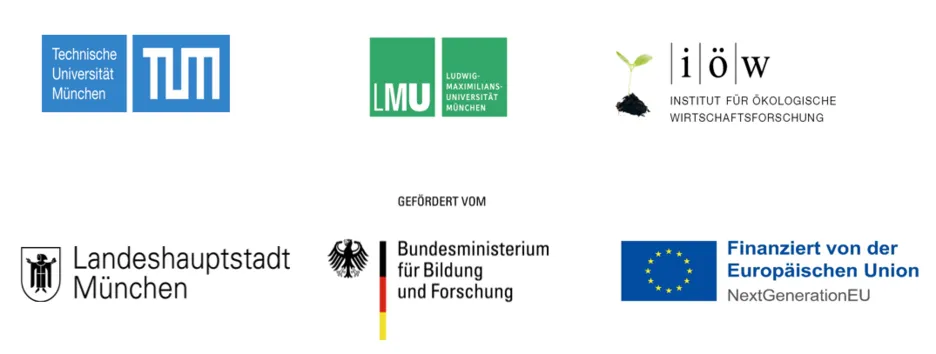Green City of the Future – climate change-resilient neighbourhoods in a growing city

Projektlaufzeit
- Definition phase: 01.05.2017 - 30.04.2018 (completed)
- Research and development phase: 01.10.2018 - 30.09.2021 (completed)
- Implementation phase: 01.12.2021 - 30.04.2024
Funding Organization
Federal Ministry of Education and Research
(funding reference 01LR1727A)
Project partners
- TUM (Koordination):
Chair of Energy Efficient and Sustainable Design and Building
Chair of Strategic Landscape Planning and Management
- City of Munich:
Department of Environment and Health, Environmental Protection Division
Department of Urban Planning and Building, Urban Planning Division - Institute for Ecological Economy Research (IÖW), Berlin
- Ludwig-Maximilians-Universität München (LMU):
Department of Sociology, working party on “Social structure and environmental adaptation”
Summary
During the six-year project period (2018-2024), the interdisciplinary project "Green City of the Future", funded by the Federal Ministry of Education and Research, developed solutions for dealing with the consequences of climate change in growing cities using the city of Munich as an example. The inter- and transdisciplinary team consisted of employees from the Technical University of Munich (Chair of Strategy and Management of Landscape Development and Chair of Energy Efficient and Sustainable Planning and Building), Ludwig-Maximilians-Universität München, the Institute for Ecological Economy Research and the City of Munich (Department of Climate and Environmental Protection and Department of Urban Planning and Building Regulations).
The aim was to support cities in achieving their long-term climate policy goals and to promote the development of climate-resilient neighborhoods. In addition to the further development of existing climate protection and climate adaptation strategies, against the backdrop of climate change, the focus was primarily on the consideration of green and open spaces, which are under extreme pressure due to rising population figures. To this end, the effect of green adaptation measures was examined based on models - both for the urban climate and water balance as well as for energy efficiency and sustainability in existing buildings. In six Munich city districts, the living labs in addition to the regulatory services of green infrastructure for climate adaptation and climate protection aspects in the building sector, the perspectives and potential of urban society for a climate-adapted city were also researched.
Through its practice-oriented work, the research team has developed adaptation measures that can be taken at governance, building and open space level to enable effective climate adaptation and climate protection. The findings of the individual project phases have been published in the form of various publications and provide an in-depth insight into the project results. Below you will find an overview of the research and development phase and the implementation phase of the research project.
I. Research questions of the Definition phase and Research and development phase
- Which factors and instruments are effective in planning processes for the implementation of green infrastructure?
- What ecosystem services does green infrastructure (GI) provide for climate adaptation and climate protection?
- How can land requirements for green infrastructure and housing requirements be reconciled from the perspective of different target groups?
- What obstacles can hinder the implementation of green infrastructure measures and how can these be reduced?
- How can the environmental impact of building structures and technical building equipment be optimized over the life cycle of buildings?
- How does the urban population deal with increasing heat and urban density, and how can greenery help?
- How can urban quality of life be improved through green infrastructure and how can urban society be activated for this?
- How do we want green, liveable neighborhoods in the growing city in the face of climate change in the long term?
During the three-year research and development phase (R+D phase), several real-world laboratories were established in Munich to explore ways of creating climate-resilient green districts in growing cities. The work was carried out in existing districts, redevelopment and new development areas with varying degrees of density, all against the backdrop of climate change.
The working group 'Local Fit - Social Structure and Environmental Adaptation' at the Institute of Sociology at Ludwig-Maximilians-Universität in Munich examined the social dimensions of climate change in urban areas. The research conducted by the Technical University of Munich and the City of Munich focused on two main topics. The team collected data through various (micro)climatic studies and simulations at the neighborhood, block, and building levels. The data focused on topics such as ventilation, the climate impact of vegetation (with a focus on trees), and life cycle analyses of buildings. Additionally, the team researched how to integrate climate protection and climate adaptation into current planning approaches and instruments.
The Institute for Ecological Economy Research (IÖW) conducted an analysis of the social and economic aspects of green infrastructures for climate-resilient inner-city development. The team worked with stakeholders to develop visions for the future of various sample neighborhoods, resulting in ideas for designing green, climate-resilient neighborhoods in the future.
Further information on the individual work packages can be found in the respective R&D phase brochures.
II. Implementation and consolidation phase

The project has been in the implementation and consolidation phase since December 2021. The aim of "Green City of the Future II" is to transfer the knowledge gained in the R&D phase into practice:
On the one hand, so-called "mainstreaming" is intended to achieve an early and thus effective integration of climate adaptation and climate protection aspects into planning practice. To this end, competition processes in the city of Munich are accompanied by research and practice partners and urban working principles for urban and urban land-use planning procedures are developed with regard to climate adaptation and climate protection. These were summarized in a "Guide for urban planning/landscape planning competitions". In addition to questions on how green and blue infrastructure measures can be taken into account in designs and competition procedures and what responsibility the competition participants bear for this, the guide also provides information on the ideal time for integration. The "Instructions for urban planning/landscape planning competitions" including the appendices can be found here (only available in german).
On the other hand, "Capacity Building" develops application-oriented training courses and assistance for the holistic and integrative implementation of climate adaptation and climate protection measures in exchange with practitioners. The associated formats are designed for self-study and interaction in groups and are aimed primarily at planning practitioners, as well as representatives from the (housing) industry and civil society.
You will find the information sheets, checklists and guidelines at the website (only available in german).
In a final conference on November 6, 2023, the four project partners presented their results and discussed together with city representatives and experts how a climate-resilient future can be achieved in growing cities. A short summary of the event can be found here.
Project team
- Prof. Dr. Simone Linke 1,2
- Sabrina Erlwein 1,2
- Sandra Feder 2
- Kathrin Theilig 2
- Priscila Stark 2
- Doris Bechtel 2
- Andrea Skiba 1
- Farzan Banihashemi 1
- Julia Brasche 1
- Christina Meier-Dotzler 1
- Hannes Harter 1
- Student assistants: Marion Schiffer 2, Selina Möbius 2, Gina Fehringer 2
1 Research and development phase
2 Implementation and stabilization phase
